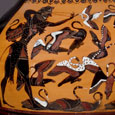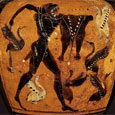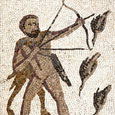STYMPHALIDES
Greek Name
Ορνιθες Στυμφαλιδες
Transliteration
Ornithes Stymphalides
Latin Spelling
Ornithes Stymphalides
Translation
Stymphalian Birds
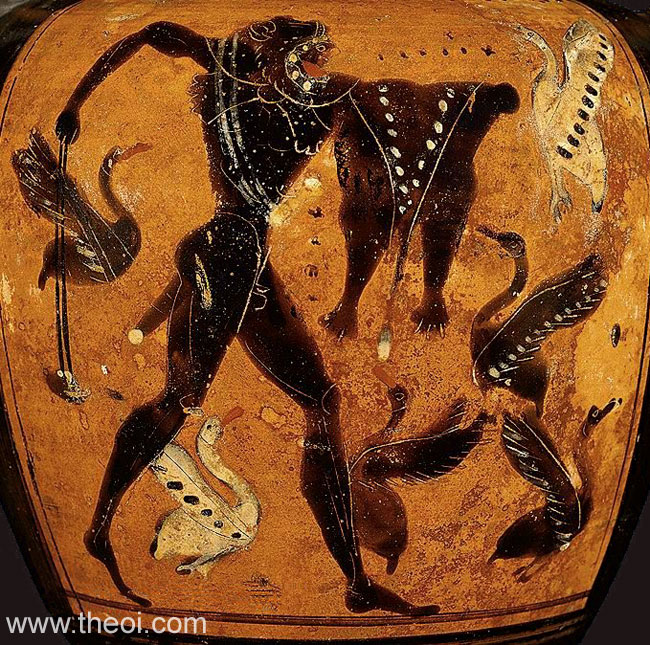
THE ORNITHES STYMPHALIDES (Stymphalian Birds) were a flock of man-eating birds which haunted Lake Stymphalis in Arkadia (Arcadia). Herakles' destroyed them as the sixth of his twelve labours, employing a rattle to rouse them from the thick vegetation surrounding the lake and then felling them with his arrows or a sling.
The birds were perhaps set amongst the stars as the constellations Aquila and Cygnus which sit on either side of Sagitta, the arrow of Herakles.
The Stymphalides were sometimes identified with the arrow-shooting Ornithes Areioi (Birds of Ares) encountered by the Argonauts on the Black Sea.
FAMILY OF THE BIRDS
PARENTS
STYMPHALOS & ORNIS (Mnaseas Frag, Scholiast on Apoll. Rhod. 2.1054)
ENCYCLOPEDIA
STYMPHA′LIDES (Stumphalides), the celebrated rapacious birds near the Stymphalian lake in Arcadia, whence they were driven by Heracles and compelled to take refuge in the island of Aretias in the Euxine, where they were afterwards found by the Argonauts. They are described in different ways, but most commonly as voracious birds of prey, which attacked even men, and which were armed with brazen wings, from which they could shoot out their feathers like arrows. (Apollod. ii. 5. § 2; Paus. viii. 22. § 4; Hygin. Fab. 30 ; Schol. ad Apollon. Rhod. ii. 1053.) They are said to have been brought up by Ares. (Serv. ad Aen. viii. 300.) According to Mnaseas (ap. Schol. ad Apollon. Rhod. ii. 1054), they were not birds, but women and daughters of Stymphalus and Ornis, and were killed by Heracles because they did not receive him hospitably. In the temple of the Stymphalian Artemis, however, they were represented as birds, and behind the temple there were white marble statues of maidens with birds' feet. (Paus. viii. 22. § 5.)
Source: Dictionary of Greek and Roman Biography and Mythology.
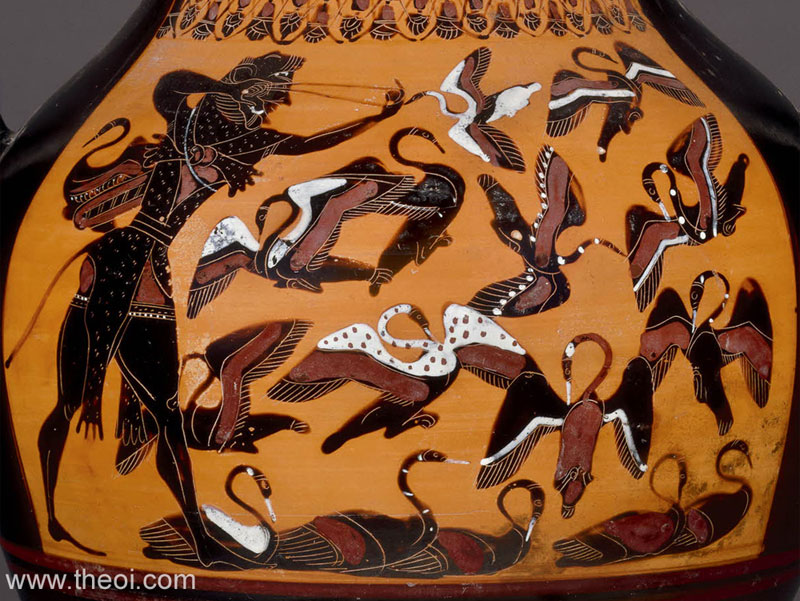
CLASSICAL LITERATURE QUOTES
Pseudo-Apollodorus, Bibliotheca 2. 92 (trans. Aldrich) (Greek mythographer C2nd A.D.) :
"For his sixth labor Herakles (Heracles) was ordered to drive off the Stymphalian Birds. At the polis of Stymphalos (Stymphalus) in Arkadia (Arcadia) was a lake called Stymphalis in a dense growth of trees. Great numbers of birds gathered there for safety, in fear of being seized by the wolves. Herakles was stumped by the problem of driving the birds out of the woods, but Athena got some bronze noise-makers from Hephaistos and gave them to him, and by shaking these from a mountain adjacent to the lake frightened the birds. Not enduring the racket, they flew up in fear, and in this manner Herakles reached them with his arrows."
Apollonius Rhodius, Argonautica 2. 1052 ff (trans. Rieu) (Greek epic C3rd B.C.) :
"[Amphidamas son of King Aleus of Arkadia recounts the labour of Herakles :] ‘Herakles when he came to Arkadia, was unable with bow and arrow to drive away the birds that swam on the Stymphalian Lake. I saw the thing myself. What he did was to take his stand on a height and make a din by shaking a bronze rattle; and the astounded birds flew off into the distance screeching for fear.’"
Strabo, Geography 8. 6. 8 (trans. Jones) (Greek geographer C1st B.C. to C1st A.D.) :
"In Stymphalos (Stymphalus) in Arkadia, that is, in the lake there which is called the Stymphalian Lake, which mythology makes the home of the birds that were driven out by the arrows and drums of Herakles; and the birds themselves are called Stymphalides."
Pausanias, Description of Greece 8. 22. 4 (trans. Jones) (Greek travelogue C2nd A.D.) :
"There is a story current about the water of the Stymphalos (Stymphalus), that at one time man-eating birds bred on it, which Herakles is said to have shot down. Peisander of Kamira (Camira), however, says that Herakles did not kill the birds, but drove them away with the noise of rattles.
The Arabian desert breeds among other wild creatures birds called Stymphalian, which are quite as savage against men as lions or leopards. These fly against those who come to hunt them, wounding and killing them with their beaks. All armour of bronze or iron that men wear is pierced by the birds; but if they weave a garment of thick cork, the beaks of the Stymphalian birds are caught in the cork garment, just as the wings of small birds stick in bird-lime. These birds are of the size of a crane, and are like the ibis, but their beaks are more powerful, and not crooked like that of the ibis. Whether the modern Arabian birds with the same name as the old Arkadian birds are also of the same breed, I do not know. But if there have been from all time Stymphalian birds, just as there have been hawks and eagles, I should call these birds of Arabian origin, and a section of them might have flown on some occasion to Arkadia and reached Stymphalos. Originally they would be called by the Arabians, not Stymphalian, but by another name. But the fame of Herakles, and the superiority of the Greek over the foreigner, has resulted in the birds of the Arabian desert being called Stymphalian even in modern times. In Stymphalos there is also an old sanctuary of Stymphalian Artemis, the image being of wood, for the most part gilded. Near the roof of the temple have been carved, among other things, the Stymphalian birds. Now it was difficult to discern clearly whether the carving was in wood or in gypsum, but such evidence as I had led me to conclude that it was not of gypsum but of wood. There are here also maidens of white marble, with the legs of birds, and they stand behind the temple."
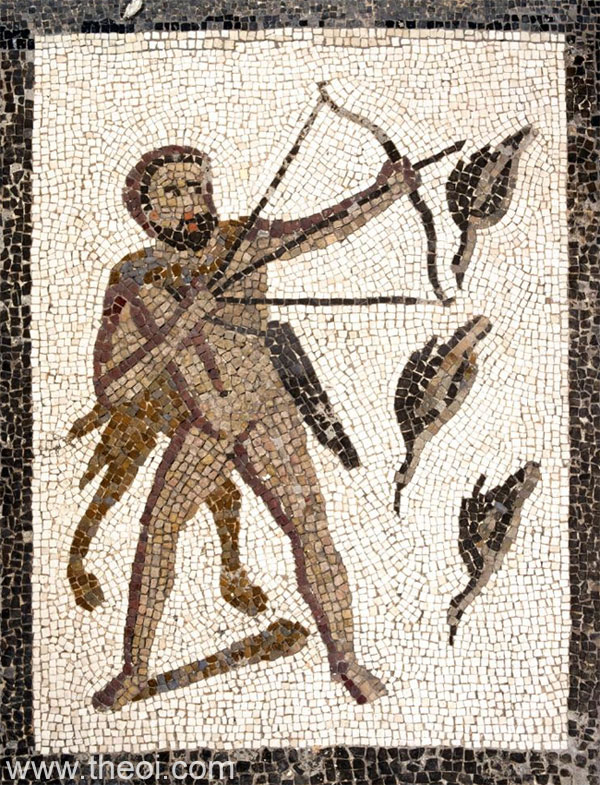
Diodorus Siculus, Library of History 4. 13. 2 (trans. Oldfather) (Greek historian C1st B.C.) :
"Herakles then received a Command to drive the Birds out of the Stymphalian Lake, and he easily accomplished the Labour by means of a device of art of by ingenuity. The lake abounded, it would appear, with a multitude of birds without telling, which destroyed the fruits of the country roundabout. Now it was not possible to master the animals by force because of the exceptional multitude of them, and so the deed called for ingenuity in cleverly discovering some device. Consequently he fashioned a bronze rattle whereby he made a terrible noise and frightened the animals away, and furthermore, by maintaining a continual din, he easily forced them to abandon their siege of the place and cleansed the lake of them."
Quintus Smyrnaeus, Fall of Troy 6. 227 ff (trans. Way) (Greek epic C4th A.D.) :
"[Amongst the scenes depicted on the shield of Herakles' grandson Eurypylos :] Were seen the fierce Stymphalian Birds, some arrow-smitten dying in the dust, some through the grey air darting in swift flight. At this, at that one--hot in haste he seemed--Herakles sped the arrows of his wrath."
Pseudo-Hyginus, Fabulae 30 (trans. Grant) (Roman mythographer C2nd A.D.) :
"He [Herakles] killed with his arrows on the island of Mars [Ares] the Stymphalian Birds which shoot their feathers out as arrows."
[N.B. Hyginus identifies the arrow-feathered birds of the Argonaut adventure with the Stymphalian birds slain by Herakles.]
Ovid, Metamorphoses 9. 187 ff (trans. Melville) (Roman epic C1st B.C. to C1st A.D.) :
"You [Herakles] gave deliverance . . . to Stymphalides' broad waters."
Seneca, Hercules Furens 243 ff (trans. Miller) (Roman tragedy C1st A.D.) :
"[The labours of Herakles :] And the Stymphalian birds, wont to hide the day with veiling wings, did he not bring down from the very clouds?"
Seneca, Medea 771 ff :
"[Amongst the fabulous ingredients used in a spell by the witch Medea :] To thee [Hecate] I offer . . . these the quills of the wounded Stymphalian bird which felt the darts of Lerna [i.e. the arrows of Heracles]."
Statius, Thebaid 4. 297 ff (trans. Mozley) (Roman epic C1st A.D.) :
"The mountains [of Arcadia] famed for Hercules' might, Erymanthos home of monsters [the boar], and Stymphalos with its clanging bronze [i.e. the rattle with which he disturbed the birds]."
ANCIENT GREEK & ROMAN ART
SOURCES
GREEK
- Apollodorus, The Library - Greek Mythography C2nd A.D.
- Apollonius Rhodius, The Argonautica - Greek Epic C3rd B.C.
- Diodorus Siculus, The Library of History - Greek History C1st B.C.
- Strabo, Geography - Greek Geography C1st B.C. - C1st A.D.
- Pausanias, Description of Greece - Greek Travelogue C2nd A.D.
- Quintus Smyrnaeus, Fall of Troy - Greek Epic C4th A.D.
ROMAN
- Hyginus, Fabulae - Latin Mythography C2nd A.D.
- Ovid, Metamorphoses - Latin Epic C1st B.C. - C1st A.D.
- Seneca, Hercules Furens - Latin Tragedy C1st A.D.
- Seneca, Medea - Latin Tragedy C1st A.D.
- Statius, Thebaid - Latin Epic C1st A.D.
OTHER SOURCES
Other references not currently quoted here: Scholiast on Apollonius' Argonautica 1054, Tzetzes Chiliades 2.291, Servius on Vergil's Aeneid 8.300.
BIBLIOGRAPHY
A complete bibliography of the translations quoted on this page.
